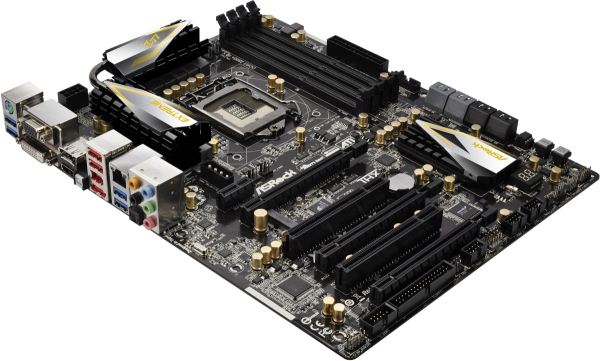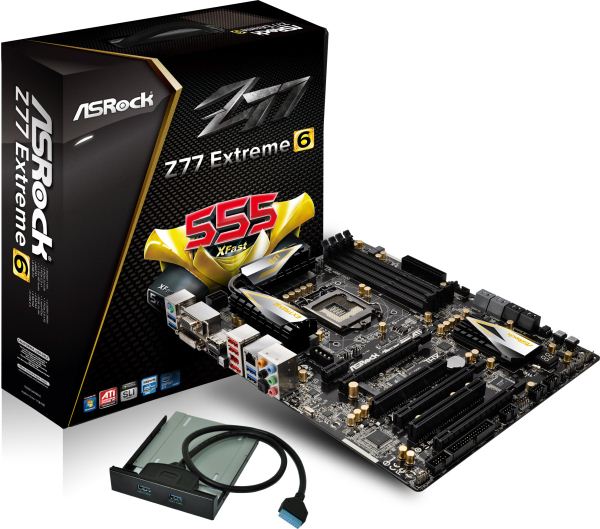ASRock Z77 Extreme6 Review: Legacy Bites Back
by Ian Cutress on July 13, 2012 2:00 PM EST- Posted in
- Motherboards
- ASRock
- Z77
The ASRock Z77 Extreme6 looks like a good motherboard on paper. If we do direct comparisons to the Z77 Extreme4, we have more substantial heatsinks, a floppy port, the full array of video outputs and a third PCIe slot at the bottom powered from the chipset.
The board itself is slightly bigger than the Extreme4, because the Extreme4 was actually smaller-than-ATX. However, the extra real estate is costing another $35, and we are not getting anything in the way of performance that excels. A quick glance over our benchmark suite and you will notice that the Z77 Extreme6 just does not light up the charts. It is usually in the middle of the road, of even worse, at the bottom.
The main thing the Z77 Extreme6 has going for it is the overclocking. All of the auto overclocking options worked first time, and plugging in my normal overclocking technique gives us some of the best results we have ever had for 4.7 GHz. Nevertheless, I did experience issues in getting my memory kit (G.Skill DDR3-2400 9-11-11) to work properly at XMP. Another plus side is that we get that awesome USB 3.0 front bracket in the box which doubles as an SSD holder.
Software wise, we do get a nice selection of network management software as well as RAM-Disk tools for temporary files. The software needs to be all bundled together as much as possible to feel more streamlined to users, as well as pulling some of the features in the BIOS (Dehumidifier, Online Management Guard) out into the software.
The BIOS is well built and laid out appropriately. There is room to move with regards how graphical BIOS can capture the imagination of the artist, and I am told we should expect something better for the later chipsets due out this year.
Simply put, some motherboards are a joy to work with. Every corner you turn they give you a little bit more. Even if the differences to other motherboards are minor, often a little spark improves your experience. ASRock ideas such as Internet Flash and OMG are good, but their implementation needs to be refined. ASRock are on the road to becoming one of the top tier manufacturers and joining the ranks of ASUS and Gigabyte, but the Z77 Extreme6 is not it. It gives you a nice overclock that removes the performance issues at stock speeds, but I cannot find much to get excited about.












35 Comments
View All Comments
IanCutress - Monday, July 16, 2012 - link
You would be surprised at how regular these timings are. For the 10.81 seconds, I got that on my manual stop watch three times in a row. To do as you suggest would be a heavily distorted effort vs. reward, especially for motherboard reviews. Interesting exercise though, not sure if it would be possible. Not that I'd know how either :)Ian
Demon-Xanth - Monday, July 16, 2012 - link
These days I think the truly best way to support legacy is by add-in cards, and am kind of surprised nobody has come up with a 486 era style I/O card that has serial, parallel, floppy, and IDE on a single card. Just use an older PCI southbridge on a PCIe bridge and you can add some USB to the mix as well.stedaniels - Tuesday, July 24, 2012 - link
Hi,I've been doing some research on this board and notice that you kept referring to the mini PCIe slot as an mSATA slot. While these are physically the same slot size, they are electrically different. Both the specs at the end of the first page, and on the ASRock website state that this is a mini PCIe slot and there is no mention of it being an mSATA slot on any of the official documentation.
Was this a mistake during the review, or are the ASRock specs wrong?
Cheers,
Steve
Mike89 - Friday, January 11, 2013 - link
The settings I've tried give voltage readings way different than this review. For example the review stated the automatic overclock of 4.4 gigs at 1.096 volts at load but when I used that same setting I got a voltage of 1.22 at load. That's quite a bit of difference. Other oc settings I tried that were in the review were also a lot different than the view being they were all higher voltages than the review stated. Can't quite figure out why that is.flexy - Tuesday, April 24, 2018 - link
This is an older article, but since I am OC testing an older Haswell system right now.These numbers seem STRANGE if not outright fantasy to me. What is that "ES" version of the i5 anyway, I can't get any information on this.
The article states they run at 44x multi stable w/ 1.096V in bios, in OCCT/Povray, and stable at 1.100 in bios (1.096 measured under load) at 45x, in OCCT and Povray. Of course, LLC = 1.
What "wonder chip" is that supposed to be that runs stable at a 45x multi in OCCT at 1.096 volts? I am having a very hard time taking these numbers seriously, unless you used some extremely carefully select CPUs with amazingly low power requirements and temps for your testing. (At these voltages I can't even get into the OS, even with LLC1, not to mention OCCT.)